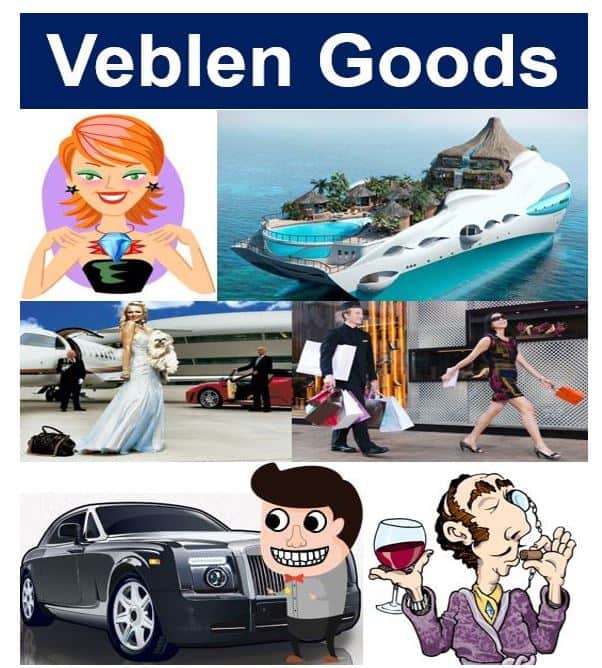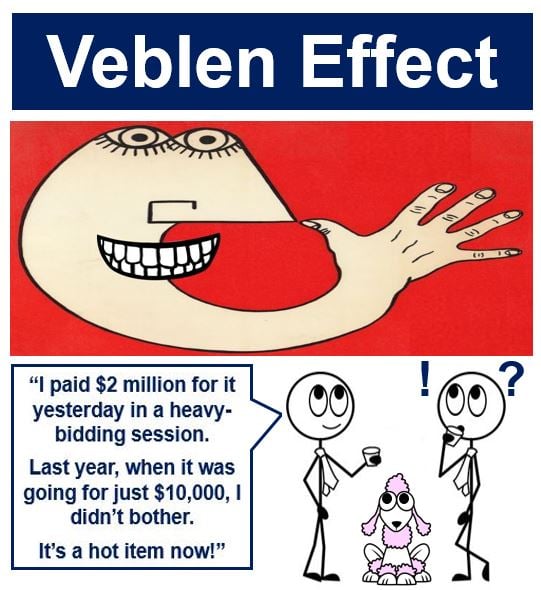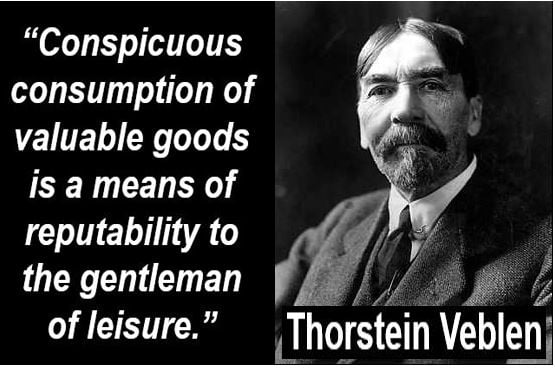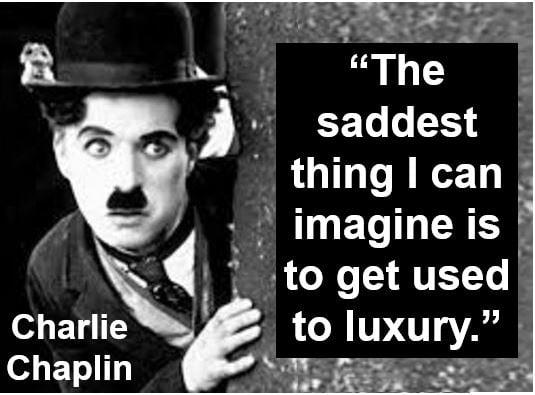What are Veblen goods? Definition and meaning
Veblen Goods are luxury goods or superior goods whose prices do not follow the typical economic laws of supply and demand. In most cases, when something becomes more expensive, demand for it declines. The opposite occurs with Veblen Goods – when their prices rise, people want more of them – and demand grows. Consumers buy these types of products mainly to enhance their status – they are status symbols.
In other words, they defy the typical relationship between price and demand because they serve as a marker of wealth and social status, where the higher price tag itself makes the good more desirable for those who wish to signal their high economic standing or discerning taste
Examples
Examples of Veblen goods include expensive Swiss watches, designer handbags, certain wines, jewelry, and luxury cars. They are in demand because they are expensive. Put simply, people who buy them want to show that they have style, class, money, and good taste.
When a man buys a $25,000 Rolex watch or a woman gets a pair of ultra-expensive diamond earrings, they usually intend to let others know. If the price of diamond products or Rolex watches suddenly plummeted dramatically, demand for them would probably deteriorate because they would lose that status-enhancing power.

The Veblen Effect
Demand for Veblen goods in an economy is a function of the Veblen Effect – either the belief that more expensive things have superior quality, or the desire for conspicuous consumption – people purchase them to show off.
The term Veblen goods was named after the Norwegian-American economist and sociologist Thorstein Bunde Veblen (1857-1929). Mr. Veblen was famous as a witty critic of capitalism.
He identified conspicuous consumption as a way to gain status in his book The Theory of the Leisure Class (1899).
In the Michigan Journal of Economics, Joshua Ravishandran defines Veblen goods as follows:
“Veblen goods are products that increase in demand as the price rises, resulting in an upward sloping demand curve instead of a downward sloping demand curve.”
“This is a good that is purchased to portray one’s status. This means that wealthy individuals purchase these goods on the basis that they are expensive.”
 Do you think such Veblen goods as the one in this image (fictitious example) exist? A year ago, this consumer was not interested. But after it – in his perception – increased in value, he was willing to pay last year’s asking price times two hundred (10,000 x 200 = 2 million).
Do you think such Veblen goods as the one in this image (fictitious example) exist? A year ago, this consumer was not interested. But after it – in his perception – increased in value, he was willing to pay last year’s asking price times two hundred (10,000 x 200 = 2 million).
Veblen goods vs. Giffen goods
Although both Veblen goods and Giffen goods disobey the traditional laws of supply and demand, they are completely different – the former refers to luxury items while the latter describes basic essential goods that poor people cannot do without.
Demand for Giffen goods also rises when prices increase. For example, in Victorian Britain bread was an essential food item for poor people. If the price of bread rose, poor households could not switch to other more expensive alternatives like meat.
They ended up buying even more bread and less of other foods like meat, or even gave up meat altogether, because bread was the only food they could afford.
Imagine you have a budget of $60 to buy chicken breast and potatoes to provide for all your meals for 10 days. Potatoes cost $1 each and chicken $20 per packet. You may decide to purchase 20 potatoes for $20 and two packets of chicken breast for $40 over the ten-day period.
You can keep yourself alive on that – you will have on average two potatoes plus one fifth of a packet of chicken per day.
Suddenly, potatoes go up to $2 each. You could still buy two packets of chicken. If you did, you would only have enough money to buy ten potatoes. This might not be enough to meet your daily calorie requirement. You could buy less chicken, for example one packet, and twenty potatoes.
Imagine potatoes went up again – to $2.50. If you bought one packet of chicken, you would have $40 dollars left for potatoes – sixteen of them. You would not be eating enough calories each day to keep yourself going.
However, if you stopped purchasing chicken altogether and just bought potatoes, you could buy 24 of them. You would be closer to your daily calorie requirement if you stopped buying chicken.
This is an example of the potato as a Giffen good. When one potato cost just $1, you bought 20 of them every 10 days. When the price rose to $2.50, you bought 24 of them.
So, although Veblen goods and Giffen goods are in greater demand when their prices go up, the reasons for this are very different. In one case the consumer is either seeking top quality or wants to show off, while in the other case it is the only way a poor person can manage.
Additionally, the allure of Veblen goods is amplified by their often limited availability, enhancing their appeal to those seeking exclusivity beyond just high cost.
 Thorstein Bunde Veblen (1857-1929) was a Norwegian-American economist-sociologist. He was well known for his witty and critical remarks on capitalism. He attacked production for profit, and had a great influence on socialist thinkers who sought to criticize capitalism in a Non-Marxist way. (Image: Wikipedia)
Thorstein Bunde Veblen (1857-1929) was a Norwegian-American economist-sociologist. He was well known for his witty and critical remarks on capitalism. He attacked production for profit, and had a great influence on socialist thinkers who sought to criticize capitalism in a Non-Marxist way. (Image: Wikipedia)
Veblen goods – related concepts
The Veblen effect is one of a group of theoretically possible anomalies in the general theory of demand in economics. Examples of other related effects are:
– Snob Effect: consumers want to use exclusive items where price reflects quality, style, good breeding, culture, etc. Consumers prefer an item because it is different from those commonly preferred.
 Sir Charles Spencer ‘Charlie’ Chaplin (1889-1977) was a British comic actor, filmmaker and composer who became one of the first international film stars during the era of silent movies. He is considered one of the most important figures in the history of the movie industry. He was born in London in a poor household. He started performing at a very young age, touring music halls and later working as a comedian and stage actor. (Image: DMG Entertainment)
Sir Charles Spencer ‘Charlie’ Chaplin (1889-1977) was a British comic actor, filmmaker and composer who became one of the first international film stars during the era of silent movies. He is considered one of the most important figures in the history of the movie industry. He was born in London in a poor household. He started performing at a very young age, touring music halls and later working as a comedian and stage actor. (Image: DMG Entertainment)
– Bandwagon Effect: this is a psychological effect in which the preference for an item grows as the number of consumers buying it increases.
– Network Effect: as the number of people with, for example Facebook or telephones, increases, the value of being on Facebook or having a telephone grows too, because the user can reach more people.
– Common Law of Business Balance: people may see a cheap article and think ‘You get what you pay for’. They may conclude that a low price for a product suggests that the maker used shortcuts, he or she may have used cheaper materials, and compromised on quality.
Normal and inferior goods
– Normal Goods are goods for which demand grows when incomes rise. However, demand for luxury goods increase faster than for normal goods when incomes go up.
– Inferior Goods are goods for which demand falls when people’s incomes rise. For example, as soon as most people can afford it, they stop using public transport and move around in their own private vehicle. Public transport is an inferior good – as incomes go up, demand for it falls.
Goods that people buy to boost their socioeconomic status, impress others, make those around them think that they have money, taste, class and style, are called positional goods.
Types of goods in market economics
In the world of market economics and finance, a variety of terms are employed to categorize “goods.” Let’s explore a selection of these classifications:
Staple items that see an increase in consumption as their prices rise due to their essential nature for low-income consumers.
Example: “In lean times, the cheap staple bread acts as a Giffen good, seeing higher consumption as its price increases.”
Assets used for the production of other goods and services.
Example: “The factory’s expansion involved acquiring new capital goods for enhanced productivity.”
Items bought for personal use.
Example: “Food and clothing, essential consumer goods, fill the aisles of supermarkets.”
Services or products available to all, without exclusive consumption.
Example: “Street lighting is a public good that benefits the entire community at night.”
Personal electronics for multimedia and computing.
Example: “His birthday list included the latest brown goods to outfit his gaming setup.”
Major household appliances, often in white.
Example: “Renovations included modern white goods to boost kitchen efficiency.”
Products whose demand climbs as incomes rise.
Example: “Families often shift to higher-quality groceries, normal goods, with increased earnings.”
Alternatives that can replace each other in use.
Example: “Amidst a coffee shortage, many switched to herbal tea, a substitute good.”
Products purchased on a whim without premeditation.
Example: “At the store’s exit, the colorful magazines, typical impulse goods, caught her attention.”
Everyday items used within the home.
Example: “Post-move, their shopping list was filled with household goods to furnish the new place.”
Video – What are Veblen goods?
This video, from Marketing Business Network, our sister channel on YouTube, explains what ‘Veblen Goods’ are using easy-to-understand language and examples.

